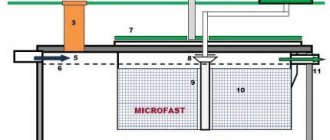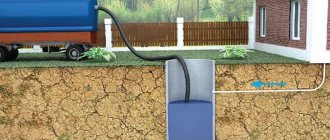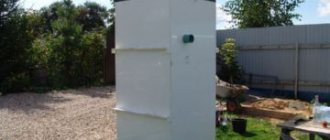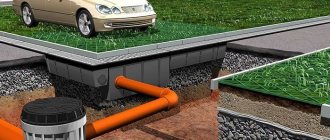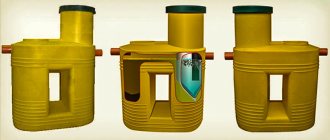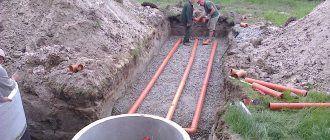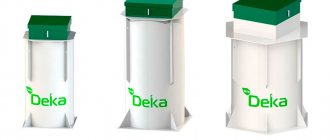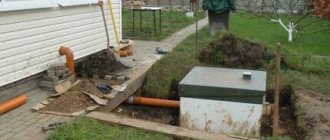The presence of an autonomous sewer system in a country house is one of the mandatory requirements that potential owners place on them. And this is correct - few people want to jump outside for natural needs when the temperature drops below -20...-30 degrees, and stays at this level for weeks. Therefore, many modern country houses have all the benefits of civilization. But many people have a completely reasonable question: “Will sewerage cause problems in winter?” It will be very useful to study this issue in as much detail as possible.
Operating a septic tank in winter
If the system works permanently, then there is nothing to be afraid of. Septic tanks operating in winter do not require additional heating or any special conditions. The fact is that constant drainage of wastewater at room temperature will prevent the system from freezing. The most important thing is not to open the lid in extreme cold, otherwise the liquid may freeze. The lid itself is already insulated and fits hermetically to the tank. There is no need to insulate it, since biomass, when decomposing, releases additional heat. In addition, the compressor operates permanently.
How will the septic tank work in winter if you come to the dacha only on weekends? Isn't it better to turn it off? No, because bacteria will only multiply with constant aeration (bubbling). To save money, you can install a special relay that periodically turns off the power. However, even systems for families of four to five people are not particularly expensive in terms of electricity.
Insulation for the cold season
After purchasing the Topaz system, you need to read the instructions. It describes in detail not only the installation process, but also the operating features. It is better not to neglect this information. It is also important to follow the recommendations for insulating the device for the winter.
Polystyrene foam is often used to insulate a septic tank.
Recommendations on how to properly insulate a septic tank:
- Complete drainage of water from the chamber is not allowed. Then the structure can emerge in the spring.
- All insulation and conservation operations must be performed sequentially.
- The lid requires mandatory insulation. Dense material will help with this. They can be polystyrene foam, mineral wool, or straw. Any available or specially purchased tools will come in handy.
- Preservation should be carried out before severe frosts begin, but it is already colder. It is better to carry out all processes at the beginning of winter.
- If the septic tank is used constantly, then there is no need to preserve it.
If winters in the region are not cold, then there is no need to preserve the device. Insulating the device will help you survive the harsh winter, since it is important for bacteria to create comfortable living conditions. The temperature inside the chambers must be maintained at +4 degrees.
The Topaz septic tank is a durable and reliable design that can withstand cold temperatures down to -15 degrees. But for northern regions or in case of significant interruptions in the operation of the device in winter, it is recommended to preserve the equipment. To do this, it is properly prepared and insulated. The work is not difficult, and you can do everything yourself.
Preservation of the septic tank
What to do with a septic tank in winter if you are not going to live in a country house during the cold season? It must be preserved without fail. The main disadvantage of preservation is that the spontaneous generation of bacteria in the spring will take from one to two weeks. Preservation instructions are included with each installation. The whole job will take you about an hour or two. If you don’t want to do it yourself, you can call specialists.
We list all the stages of conservation of volatile systems:
- disconnection from power supply. All biological treatment stations are energy dependent. They are turned off using a remote control or switches in the house. In some stations, you must first turn it off using a key located on the control unit of the installation.
- cleaning the system chambers from sludge.
- Removing the compressor.
- removing the pump. After this, the product is inspected, cleaned and repaired if necessary.
- checking the fluid level. If there is less water, add clean water so that each chamber contains 2/3 of the total volume.
- install floats. If you live in a place with harsh winters. They are placed so that the pressure on the walls of the tank is reduced, and the resulting ice does not break the body of the installation. To do this, use ordinary plastic bottles of 1.5, 2 or 5 liters. Fill them (about a third or half) with sand and lower them into the tank so that the top of the bottles is held vertically on the surface. The caps are not screwed on completely. A rope is tied to the necks of the bottles to make them easier to get when re-opening begins.
- insulate the station cover. This is done using penoplex foam 5 cm thick. Usually four sheets are needed. The walls and cover of the station's insulating box are assembled from foam sheets. To prevent the penoplex from getting wet and preserve its properties, the finished box is covered with plastic film and pressed down around the perimeter with stones.
What is confusing about sewer installation in winter?
The first problem is the snow. Outside the city, as a rule, there is even more of it than in the city, and it covers the entire area in an even layer. However, it is easily and quickly removed by the installers themselves; the client does not have to worry about it.
The second problem follows from the first problem – transport accessibility. Snow covers not only the site, but also the roads, which are not cleaned regularly in gardens or cottage villages. This may cause the installation to be postponed, so it is better to make sure in advance that it is possible to drive up to the site on a cargo gazelle.
The third reason for customer concern is frost. But they don’t interfere with the installers’ work at all, so the customer definitely doesn’t have to worry about it.
At what temperature is it absolutely forbidden to install a septic tank?
Plastic septic tanks are not installed at temperatures of -15C° and below. In such frost, plastic becomes brittle and is easily damaged. Ideal conditions for installing a septic tank in winter are light frosts or thaw.
Frozen ground can also be confusing. In our region, the frozen layer of soil is not as deep as is commonly believed. Practice shows that even in severe winter the freezing depth is no more than 60 cm. They fight it with an electric jackhammer.
And finally, water. An autonomous sewer system must be filled with water during installation, and in winter there may be problems with its supply. Solutions can always be found. Our installers have a pump and hoses. The water for filling the sewer can be not the cleanest; for example, water from an irrigation well or from a ditch will do. If necessary, installers will make a hole.
We have dealt with the problems of winter installation, let’s move on to the advantages.
Does the septic tank freeze in winter?
Yes, if it was not properly preserved for the winter. Also, the septic tank can freeze in winter if errors were made during installation. This mainly concerns not so much the septic tank itself, but the pipeline. Let's analyze the main errors during installation and operation:
- the pipeline is not laid deep enough, above the freezing point of the soil. At the same time, the highway is poorly insulated.
- During installation, a pipe of smaller diameter or low slope was used. The error led to stagnation of flows, and the water in a certain area froze.
- Fat deposits inside the pipeline do not allow drains to pass freely.
- there are no inflows of warm liquid into the pipeline. For example, due to a malfunction, only cold water flows into the main line.
- the system is located far from a residential building.
If it is not possible to bury the septic tank
Alas, in some cases, dacha owners simply do not have the opportunity to install a septic tank below the freezing depth of the soil. In this case, insulation should be approached much more seriously - this is no longer a precaution, but a necessity.
The septic tank should be insulated when installing it. Expanded clay or foam chips should be used as thermal insulation materials - low cost combined with good thermal insulation make these materials the optimal solution to the problem.
Some attention should be paid to the thermal insulation of pipes leading to the septic tank. It is best to use polymer pipes - they do not rust, are light in weight and are relatively inexpensive, for which they are highly valued by specialists. The pipes must be wrapped with a suitable thermal insulation material, and then placed in a shell of asbestos-cement pipe, which protects against any mechanical damage.
Insulation of sewer pipes
When laying pipes, special attention should be paid to the slope. The minimum slope should be 2 degrees, that is, 2 cm of slope per 1 meter of pipe. However, in practice, experts prefer a slope of 5-7 degrees, which ensures rapid passage of water along with the contents through the pipes. But you shouldn’t get too carried away - it’s better that the slope falls in the range from 2 to 7 degrees.
If the pipes are laid at a lower slope, there is a danger that water will not move through them. If the slope is too large, water flows through very quickly, but solid waste can linger in the pipe, accumulating and clogging it. Of course, when laying, you should avoid using corners and turns - they significantly increase the risk of blockages. When installing a sewerage system for a one-story house, pipes with a diameter of 50 mm are suitable. If we are talking about a two-story house, on the upper floors of which there are sinks, a toilet and a bath, then pipes with a diameter of 200 mm are better suited.
What to do if the system is frozen?
There are several ways to defrost a drain.
- pouring boiling water. Using a rubber hose inserted into the pipe and a funnel, boiling water is poured. The hose should rest against the ice plug. When the plug melts, the hose is pushed through the pipeline to completely dissolve the ice.
- flushing with saline solution. Having heated the water to 70 degrees using the boiler, open the tap and drain the water into the bathroom. Pre-dissolve salt in it (1:10). We wait half an hour. If the ice plug has not thawed during this time, you should use the following method.
- heating the pipe. Using a construction or household hair dryer, heat the section of the pipe that goes outside.
- caustic soda. This method should help if the traffic jam does not form near the house, but closer to the system. Mix caustic soda (3 kg), hot water (6 l), boiling water (1 l). Pour the mixture down the drain. The large amount of heat from the chemical reaction should melt the cork. This will be noticeable if the mixture begins to flow freely into the drain. You should work in a respirator, gloves and goggles.
- heating the pipe with excavation of the route. If none of the previous methods gave results, then you should use this method. To determine where the plug formed, we dig a trench. Next, using a mallet, tapping the pipe, we find out the location of the ice. The area with the congestion is heated with a hair dryer.
The second option is to live periodically in winter (on weekends)
Some homeowners have certain concerns when their country houses are not used every day in winter. In this case, there is no need to turn off the autonomous sewer system or preserve it; it will operate as normal. In our geographical area, winters are mild and frosts are rarely severe and until spring, even a switched off station has the effect of a well and freezes to 10-15 cm of ice thickness in the station chambers. And when the autonomous sewage system is working, the biological temperature of microbial habitat in the station does not fall below 10-12 °C. But at the same time, do not forget about preventive measures and look under the station cover from time to time.
Installing the system in winter
We already know that the system can be successfully operated throughout the cold period. The next advantage is that the septic tank can even be installed in winter. Let's look at the installation algorithm step by step:
- First of all, the area for the foundation pit is cleared of snow.
- Mark the dimensions of the pit on the ground and begin digging.
- drill a hole in the tank for the sewer pipe. Next, insert the pipe into the hole and seal it.
- drill a hole to drain purified water.
- At the bottom of the dug pit, a sand base is made.
- The tank is carefully lowered into the pit so that the lid is above ground level. Next, level the system, cover the edges with sand, and pour water inside.
- An alarm is mounted on the tank lid.
- A pipe is inserted into the hole intended for the water drainage pipe and sealed.
- digging a trench to the house.
- assemble and install a pump that will discharge purified water.
- a sewer pipe is inserted into the system. The trench is filled with sand.
- An electrical cable is connected to the system.
- compressors are connected.
- install a pipe that will drain purified water.
If the winter setting is “Country”
installs septic tanks at any time of the year in the territories of the Leningrad, Moscow, Pskov, Sverdlovsk and Novgorod regions. For the installation of an autonomous sewer system in winter, we provide good discounts and interest-free installments without a down payment for 6 months.
All work is carried out by professional installers. Within the company, they are constantly trained and certified, each installation is recorded for a photo report.
All of our equipment is covered by a manufacturer's warranty; in turn, we provide an installation guarantee of up to 5 years.
Recommended products
What are the dangers of a freezing septic tank?
If the septic tank freezes in winter, this can cause adverse consequences. They will be discussed in more detail below.
Hull damage
To fix the problem, you need to dismantle it and then install new equipment.
To prevent damage, do not purchase cheap or used materials. Consider how resistant they are to frost. If the stability is high, the material will last for decades.
Settlers, which are energy independent, are made from low-density polyethylene. Aeration stations with complex operation are made from high-quality polypropylene. Low pressure polypropylene acquires a glassy state at a temperature of -50°C.
Ordinary polypropylene changes structure at -5°C. At a temperature of -55°C, polypropylene changes its chemical properties, which is produced according to the principle of copolymerization with frost-resistant agents.
Damage to equipment inside the septic tank
Often, due to freezing of the septic tank, the pump, control unit, compressor and sockets are damaged.
Because of this, you will have to spend money on maintenance and repair work. To fix the problem, you need to replace or repair the equipment.
As a preventative measure, winter canning is carried out.
This is done according to this principle:
- the electrics turn off;
- the compressor is removed;
- plastic bottles with sand are installed - this helps prevent damage to the internal partitions;
- install additional insulation on top and sides with your own hands.
Reduced quality of cleaning at water temperatures below +10 °C
In this case, you need to insulate the upper part, and also increase the flow of hot water.
Systems in which the compressor supplies hot air from the room using an insulated hose do not suffer from this problem.
Before you buy a budget septic tank, think about safety. To do this, use these tips:
- Install the septic tank on the north side of the site behind the wall of the house. This way it will not be damaged by ultraviolet radiation and severe frosts.
- Insulate the upper part, which is located 40 cm from the surface of the earth. It is advisable to use expanded clay or polystyrene foam. It is better to avoid using mineral wool.
- Do not install insulation in a septic tank below 1.5 m from the ground surface. In such areas, the temperature is high, and the soil transfers geothermal heat to the septic tank. This will minimize damage.
- Do not apply insulation to walls. Otherwise, buoyancy will increase, which will lead to floating in the spring.
- Do not clear snow from the septic tank. It can be an excellent insulator.
- Inspect the fixtures inside the house to ensure they are in good working order. If the cistern is faulty, cold water will leak into the system. This will provoke suspended animation of the bacteria, and they will stop producing heat.
Installation of a septic tank made of concrete rings at sub-zero temperatures
When working with concrete rings in cold weather, the issue of concrete and formwork disappears. But there remains an equally important issue with sealing the seams. After all, special sealants are used to seal seams. And they are not at all designed to work at sub-zero temperatures, and even more so in severe frosts. Therefore, there will not be the necessary adhesion with concrete rings. Also, the sealant will not be able to achieve the required performance characteristics due to simple freezing. And in this state, the sequence of processes for normal solidification will not occur.
The result will be disastrous, because there will be no complete sealing. Groundwater will get inside and you will have to call a vacuum cleaner very often. Or, on the contrary, dirty water from the septic tank will end up in the ground. And if you have a well or a nearby well, then the contaminated wastewater will reach your drinking water.
Conclusion! If you decide to install a septic tank in winter, then feel free to order an autonomous sewerage station. If for some reason this does not suit you, then the safest thing to do is wait for the warm season.
